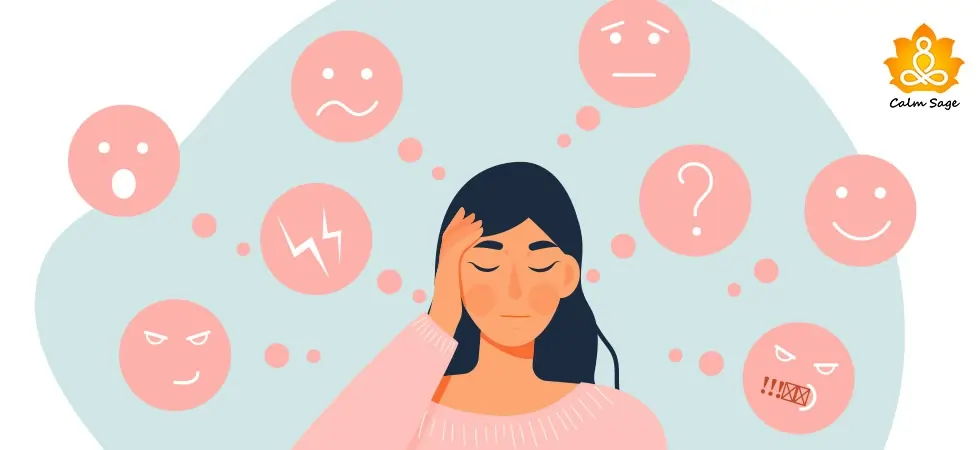Paranoid Ideation: Definition, Symptoms & Treatment (Self-Coping Tips)

List of Contents
The feeling that you’re being threatened or the belief that others are conspiring against you is what we can describe as paranoia. While these thoughts are not true, they are ever-present in people struggling with paranoia or paranoid ideation and can be psychologically distressing.
One of the common symptoms of borderline personality disorder (BPD), post-traumatic stress disorder (PTSD), and psychotic disorders such as delusional disorder, schizophrenia, etc, paranoid ideation is when you experience paranoia caused by stress.
Let’s take a closer look at what is paranoid ideation, the symptoms, what causes paranoid ideation, and how you can treat it.
What Is Paranoid Ideation?
Paranoia is when you experience the feeling that you’re being threatened, abused, or plotted against by people around you while in reality that’s not the case. Paranoia can also refer to beliefs and ideas of suspicious behavior about the intentions of others around you.
People with a borderline personality disorder or BPD, are more likely to experience paranoid ideation when dealing with stress than others.
Symptoms Of Paranoid Ideation
Some people may experience mild paranoid ideation where the thoughts and ideas may not be as harmful to one’s mental health, others experience severe paranoid ideation where the thoughts and beliefs are persistent and can be challenging to control.
Paranoid ideation symptoms can include:
- Increased anxiety
- Increased stress
- Difficulty managing relationships
- Experiencing distrust
- Experiencing disorganized thoughts
- Feeling threatened
- Feeling left out
- Feeling conspired against
- Feeling that others are being hostile towards you
- Thinking you’re being spied on
Keep in mind that paranoid ideation and delusional paranoia aren’t the same things. Where thoughts under delusional paranoia are fixed, the thoughts and ideas under paranoid ideation can be fleeting.
Paranoid ideation example can be; when you see two people in the same room talking amongst themselves and you, for a fleeting moment, believe that they are talking about you or conspiring against you.
What Causes Paranoid Ideation?
The causes of paranoid ideation are not well-known but researchers believe that certain genes, environmental factors, and imbalances in the brain chemicals might cause paranoid ideation.
Some common causes of paranoid ideation could be:
Past Trauma: People with past childhood trauma such as childhood neglect or abuse are more likely to develop conditions with paranoid ideation.
Imbalances In The Brain: Any chemical imbalance in the brain can also alter emotions and judgment causing one to develop paranoia or paranoid ideation.
Medical History: If a family member has a history of BPD, delusional disorder, schizophrenia, or other psychotic conditions, then one is more likely to develop the same.
Compromised Reasoning: When a person’s view and thoughts related to the world around them are prejudiced, then they are more likely to develop paranoid ideation.
Stress: Any kind of stress can also trigger paranoia or paranoid ideation, especially if a person is diagnosed with BPD, PTSD, or Schizophrenia.
What Is The Diagnosis Criteria?
According to the current Diagnostic and Statistical Manual of Mental Disorders (DSM-5), here are the common symptoms and signs you need to have to be diagnosed with paranoid ideation:
- Inappropriate anger outbursts followed by feelings of shame and guilt
- Having an opinion about yourself that affects your thoughts, ideas, relationships, and mood
- Taking extreme measures to avoid rejection from others
- Experiencing feelings of dissociation and having paranoid thoughts brought on by stress and anxiety
- Having a love-hate relationship with others
- Never-ending feelings of being empty inside
- Having impulsive and reckless behaviors
- Having suicidal tendencies and behaviors
- Having frequent mood swings that last for days (involving feeling depressed, anxious, and anger)
If you or your loved one are having suicidal thoughts, immediately contact your nearest emergency hotline for support. You can also connect with the helplines mentioned here:
- National Suicide Prevention Lifeline: 1800-273-8255
- Crisis Text Line: text HOME to 741741
- TrevorLifeline: 866-488-7386
- iCall: +91-9152-987-821
- AASRA: +91-9820-466-726
- Vandrevala Foundation: +91-9999-666-555
Treatment Options:
If your paranoid ideation is because of a personality disorder or psychotic condition, then it is recommended that you find the right medical and professional help. Most of the time, the treatment options for such mental health conditions include psychotherapy, medications, or a combination of both.
Psychotherapy: Some of the most common psychotherapy techniques used to treat paranoid ideation can be dialectical behavioral therapy, cognitive-behavioral therapy, and psychodynamic therapy.
Medications: Medications like antidepressants, anti-anxiety pills, antipsychotics, or mood stabilizers might be prescribed to help you minimize your symptoms.
Always consult with a physician before taking any medications. Many medications can have side effects that can worsen your symptoms.
Self-Help Coping Tips!
Paranoid ideation can be triggered due to increased stress and anxiety. When it comes to self-help, managing your stress can help cope with paranoia and paranoid ideation.
Here are some self-help coping tips for you to try:
A. Deep Breathing Techniques: One of the most common stress management techniques, deep breathing can help you increase relaxation and alleviate anxiety. Take a slow, deep breath and let go of your worries.
B. Meditation Techniques: Meditation has many health benefits, including relieving stress and anxiety. With these meditation techniques as well as practicing mindfulness meditation, you can learn to focus on the now and clear your mind of thoughts you don’t need.
C. Progressive Muscle Relaxation: This relaxation technique involves slowly constricting and relaxing your muscles. This practice can help you relax quickly and can be effective against releasing the physical symptoms of stress.
D. Visualizing: This is another relaxation technique that involves using mental imagery to help relax your mind. If you’re having paranoid thoughts you can try to focus on a soothing image in your mind that helps ground you to the present.
E. Yoga or Tai Chi: These kinds of physical exercises combine meditative and calming movements and deep breathing to help you relax – mind and body.
Paranoid ideation can include having thoughts and ideas that make you feel suspicious of others’ intents and motives. However, paranoid ideation can be controlled with the right treatment and coping strategies.
If you’re experiencing paranoid ideation, it is recommended that you seek a professional diagnosis because sometimes, paranoid ideation can be a symptom of an underlying psychological or psychotic disorder.
I hope this article helped you understand what paranoid ideation is, the symptoms of paranoid ideation, what causes it, and how you can treat paranoid ideation.
Found this article helpful? Let us know in the comments below! You can also write to us at info@calmsage.com or DM us on social media to connect with us.
Take Care!




















